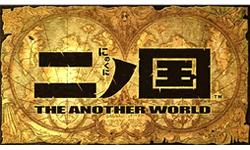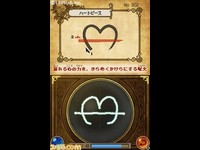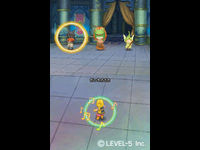|
|

|
PLATFORM
|
DS
|
BATTLE SYSTEM
|

|
INTERACTION
|

|
ORIGINALITY
|

|
STORY
|

|
MUSIC & SOUND
|

|
VISUALS
|

|
CHALLENGE
|
Moderate
|
LANGUAGE BARRIER
|
Moderate
|
COMPLETION TIME
|
20-40 Hours
|
|
OVERALL

|
+ Superb graphics.
+ Strong writing.
+ Very detailed game world.
+ The Book.
+ Simple but adaptable combat system.
- Could have gone farther with what it had.
|
Click here for scoring definitions
|
|
|
I can honestly say that I have been looking forward to this game for years. Ninokuni was first announced back in 2009, and was tentatively slated by Japanese news outlets for release in every financial quarter starting from Q4-2009. At any rate, it's safe to say that a lot of time and care went into the development of this title. That, and the potent creative combination of Level-5 and Studio Ghibli, meant that my expectations going into this game were high. And I was not disappointed.
The story opens in the town of Hotroit, a typical American town circa 1955. Young Oliver is living an idyllic existence with his mother Ally — right up to the point where tragedy strikes. From that moment onward, his life is turned upside down. His treasured doll is really an imprisoned fairy. There's a magic grimoire hidden in his fireplace. And for every person he's ever met, there exists an exact lookalike in the Another World of Ninokuni, a fairy-tale realm where cats can be kings, empires can be made to move like clockwork, and maybe (just maybe) his mother can still be rescued from her fate.
To this end, Oliver finds himself enlisted in the fight against Ninokuni's resident badguy: Shabo, the Mage of Darkness. He won't be doing it alone, of course. Aside from the fairy Shizuku, two other characters join Oliver in the fray, bringing along their own special abilities. But the bulk of the fighting will be accomplished by the Imagens.
Originally, Imagens were summoned from the hearts of magic-users by means of a simple spell. Long ago, however, large numbers of them were summoned to fight in a magic war — so many in fact that afterwards the majority went feral and now roam the land as monsters. Oliver has to summon his first Imagen, and several more join at plot points early in the game. Eventually the option to recruit wild ones becomes available, opening up the party to all manner of creatures. To their credit, the designers managed to avoid resemblances to Pokémon in all but two cases. That said, the way in which the player uses Imagens in Ninokuni bears much more resemblance to Dragon Quest V than it does to the world's most popular monster-collection franchise. Little to no emphasis is put on the collection aspect, except in regards to specific side-quests.
 A brave new world.
A brave new world.
|
|
And of sidequests, there are plenty. One of Shabo's more insidious tricks is a spell which steals a piece of a person's soul, robbing the victim of enthusiasm, courage, perseverance, confidence, faith, love, or even the ability to dream. While Oliver helps many of these poor, hollowed-out souls over the course of the main story, most are the subject of side-quests wherein Oliver must track down other people with a surplus of the appropriate emotion in order to make up for the victim's lack. These make up about half the optional content in the game. Completing side-quests gains the player stickers on the Hero's Stamp Card, which can be exchanged for useful bonuses in the game. While the game can probably be completed in 20 to 30 hours, the side material easily pads it past the 40-hour mark.
Going back to the subject of battles, combat in Ninokuni is a simple affair, though with a few bits of strategy. Oliver and his human comrades only gain new abilities after plot points (often with a new set of equipment involved), while Imagens get one skill for every stage they've grown while under Oliver's care (with a maximum of three skills, and the potential to be taught one more). The three selected members of the battle party can be chosen at the player's discretion, and one character may be swapped out per turn.
The strategy comes from exploiting elemental strengths and weaknesses, and from the placement of characters on the field of battle. The latter in particular is important, as some attacks hit horizontally, some vertically, and some diagonally along the 3x3 grid constituting the player's side. Other attacks may be blockable, if another character is standing in front of the intended target. By taking advantage of positioning to minimize or avoid damage, or by hitting enemy weaknesses, the player gains Nice Points. When a character's NP are charged to the max, that character can use a special skill unique to its type. Unfortunately, most battles are over well before anyone's NP can be charged fully, so this is something usually seen only in boss encounters. Enemies also lack the positioning system available to the player, reducing the net effectiveness of vertical-line attacks.
 Memorize this. You'll be using it a lot.
Memorize this. You'll be using it a lot.
|
|
Gameplay outside of battle isn't quite so straightforward, and this is largely because of The Book, a.k.a. Magic Master. Any discussion of interactivity in this game must begin and end with this 352-page tome of game lore. Much of it is devoted to the sort of thing one would expect of a game guide: lists of items and equipment, a description of spells and their effects, and a bestiary of all the Imagens in the game. In addition, it has full maps, frontispieces, medieval-style illuminations, a long series of fairy tales and personal accounts (some of which only make sense after one finishes the main game), clues to puzzles, and a complete substitution code which is needed to decipher various secret messages and puzzles scattered throughout the book.
It's up to the individual player to decide if Magic Master is a bane or a boon to the gaming experience. Certainly, it's as portable as any hardback novel of similar size, but not everyone carries a bag with them. The Book is also necessary for playing, since it's the only (legitimate) means to get the clues for most of the game's puzzles, passwords, and riddles. Also, in order for one to gain spells, one must first draw the runes for them on the touch-screen, and the only references are within its pages. Without a doubt it's one of the most decorative bits of realia ever to be released with a game, and makes a beautiful table book even after the game is over.
In terms of graphics, Ninokuni is everything one would expect of a collaboration with Studio Ghibli, which is to say it has possibly the best graphics ever seen for the Nintendo DS. Most of the major plot points have fully animated cut scenes, of a quality normally associated with feature films. Even minor events, such as the introductions to boss battles, are shown with CG animated cut scenes that are well above average in quality.
 Soothing the savage breast.
Soothing the savage breast.
|
|
Complementing the animation is some very solid dialogue. The main story is comfortably cliché-ridden, with twists coming at just the right places, but it's with the characters that the writing really shines. All the major figures in the plot have their own voices. In the literal sense, the voice acting is top-knotch, but "their own voices" also includes the manner in which they are written throughout the text. Even the side-quest NPCs have a bit of flavor to their speech, though nothing beats Shizuku's full-on banter in fluent Kansai-dialect Japanese. Ninokuni's musical score is as top-knotch as the rest of the package, and is a good reason to invest in headphones as the player will really want to be listening whenever possible. The various arrangements were recorded live, and are a wonderful addition to the game's atmosphere.
If there is one thing to fault the game on, it's that the puzzles and level design don't go as far as they could when it comes to exploiting the game's spell library. Of the fifty-one runes in Magic Master, only a dozen or so are used in battle. Two serve mainly plot purposes, a handful more are useful for exploration, and a few serve a purpose only once or twice throughout the game. Two are absolutely necessary for restoring Shabo's victims to perfect working order. Still, that leaves almost half the spells in The Book unused. This group of unexploited spells includes things like time travel, rain-calling, bread-making, and transformation into a variety of shapes. The possibilities are endless but never acted upon. These may play a bigger part in the game's future downloadable content, however.
While I wouldn't declare this the Best Game Ever, it's certainly the best overall game I've played in a long while. If someone were to ask me five years ago how I'd think a Dragon Quest / Ghibli crossover might turn out, this is just the sort of game I would have imagined. It's traditional where traditional works, creative in just the right spots, beautifully designed and scored, and has a level of difficulty scaled to its grade-school target demographic. In short, it's a very good game.
Review Archives
|









